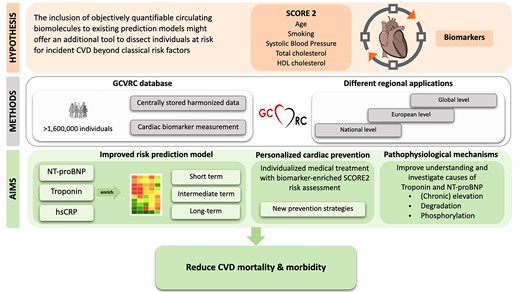-
PDF
- Split View
-
Views
-
Cite
Cite
Stefan Blankenberg, Nicholas L Mills, Christian Mueller, on behalf of the Study Group on Biomarkers of the ESC for Acute CardioVascular Care, Screening the general population: a role for cardiac biomarkers?, European Heart Journal. Acute Cardiovascular Care, Volume 11, Issue 7, July 2022, Pages 581–583, https://doi.org/10.1093/ehjacc/zuac067
Close - Share Icon Share
Cardiovascular diseases (CVDs) are the most common fatal non-communicable diseases globally, responsible for an estimated 18.6 million deaths in 2019.1 Despite the decline in its incidence and mortality rates in several countries and despite the current pandemic situation, CVD remains the major cause of morbidity and mortality in Europe.2 Therefore, risk stratification of future CVD is highly relevant for public health as well as in daily clinical routine.
Various risk prediction algorithms including the currently recommended SCORE23 model offer guidance for cardiovascular risk prediction. These are solely based on classical risk factors, including age, arterial hypertension, lipid concentrations, and smoking. However, these conventional factors were found to explain only approximately 65% of incident CVD events (Figure 1).4

Overview of the ‘Population Risk Prediction’ project. Boxes show the project hypothesis, resources and methods, and aims to tackle cardiovascular disease burden. CVD, cardiovascular disease; GCVRC,Global Cardiovascular Risk Consortium; NT-proBNP, B-type natriuretic peptide.
The inclusion of objectively quantifiable circulating biomolecules to existing prediction models might offer an additional tool to dissect individuals at risk for incident CVD beyond classical risk factors.
Out of 30 biomarkers assessed in a previous study, three have shown to add significant information on risk prediction.5 Next to the inflammatory biomarker high-sensitive C-reactive protein, cardiac-specific circulating biomarkers like B-type natriuretic peptides (e.g. NT-proBNP) and troponin assessed by highly sensitive methods are able to quantify silent myocardial injury and are strongly associated with incident CVD in apparently healthy individuals. Despite persuasive evidence that inclusion of high-sensitivity cardiac troponin and/or NT-proBNP might add predictive accuracy6 it still remains unclear, whether a clinical routine screening application of biomarkers in a general population might improve cardiovascular prevention.
Several aspects need to be clarified:
To identify whether single or combined biomarkers add predictive information in the general population.
To apply a new biomarker enriched SCORE2 prediction algorithm to European and Global population-based cohorts. Building up on existing gold standard measurements in already harmonized cohort data, the results will unravel the incremental predictive value of the cardiac biomarkers on a European and global level, and establish the enriched SCORE2 biomarker risk prediction model for short, intermediate, and long-term risk assessment.
To apply a prospective clinical trial protocol to personalize cardiac prevention treatment based on the individualized biomarker-enriched SCORE2 risk assessment.
In summary, an improved cardiovascular risk prediction on national, European and global level strengthened by biomarker inclusion and long-term data constitutes an unmet clinical need. Findings should enable the medical community to tailor personalized preventive action and significantly improve the CVD burden in the general population.
Acknowledgements
N.L.M. is supported by a Research Excellence Award (RE/18/5/34216) and a Chair Award (CH/F/21/90010) from the British Heart Foundation.
Conflict of interest: SB reports institution funding from Bayer, Siemens, Novartis and the City of Hamburg. SB is listed as co-inventor of an international patent on the use of a computing device to estimate the probability of myocardial infarction (International Publication Number WO2022043229A1) filed by the University Medical Center Hamburg-Eppendorf, Hamburg, Germany and Cardio Care AG, Davos, Switzerland, and as co-inventor and co-applicant of a Taiwanese patent on the use of a computing device to estimate the probability of myocardial infarction (Taiwanese Publication Number 202219980).
Other members of the Study Group on Biomarkers of the ESC Association for Acute Cardiovascular Care include:
Evangelos Giannitsis, MD1, Allan S. Jaffe, MD2, Kurt Huber, MD3, Johannes Mair, MD4, Louise Cullen, MD, PhD5, Ola Hammarsten, MD, PhD6, Martin Möckel, MD7, Konstantin Krychtiuk, MD8, Kristian Thygesen, MD9
1Department of Cardiology, University Heidelberg, Germany
2Mayo Clinic and Medical School, Rochester, Minnesota, USA
3Department of Medicine, Cardiology and Intensive Care Medicine, Wilhelminenhospital, and Sigmund Freud University, Medical School, Vienna, Austria
4Department of Internal Medicine III – Cardiology and Angiology, Medical University Innsbruck, Austria
5Emergency and Trauma Centre, Royal Brisbane and Women`s Hospital, University of Queensland, Australia
6Department of Clinical Chemistry and Transfusion Medicine, University of Gothenburg, Gothenburg, Sweden
7Division of Emergency Medicine, Charité-Universitätsmedizin Berlin, Germany
8Department of Internal Medicine II, Division of Cardiology, Medical University of Vienna, Austria
9Department of Cardiology, Aarhus University Hospital, Denmark




Comments